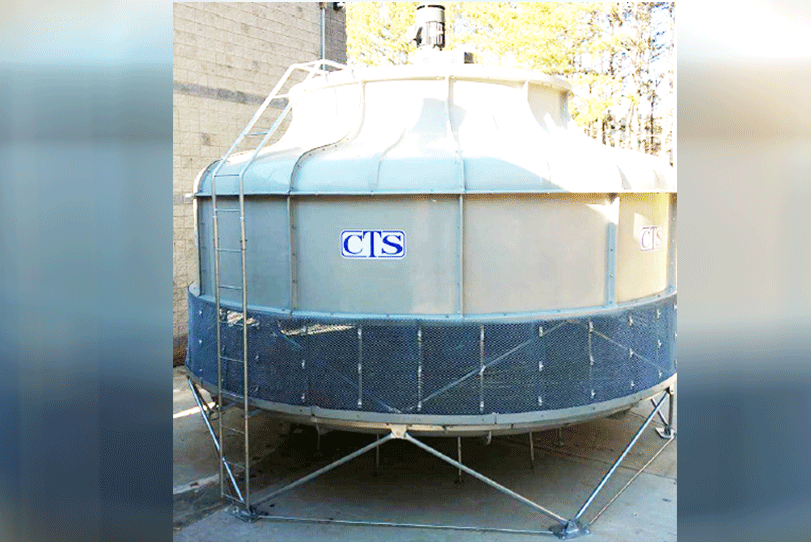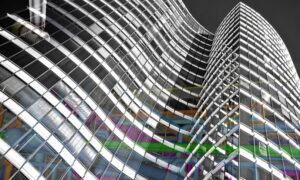Cooling towers are used in central air conditioning systems. The function of the cooling tower is to cool the warm water from the chiller condenser. Following the central air conditioning system cycle, the heat from the rooms in a building is transferred to chilled water, which is then transferred into the refrigerant, and finally to the cooling water. The cooling tower is at the final point of the heat transfer. The heat is transferred to the atmosphere. The heat in the cooling water is removed by letting moving air come into contact with it. Water is normally spread out and allowed to drop down by gravity from a height. Plastic fillings are arranged so as to increase the wetted surface of the water while it is dropping, while at the same time provide better contact between the air passages and the water. This depends on the humidity of the surrounding air. Usually the tower should be able to cool the water by about 6-degree F to 7-degree F of the air wet bulb temperature. For example, if the wet bulb temperature of the air is 78-degree F and the hot water coming to the tower from the condenser is 95-degree F, then the cooled water that leaves the tower can be 85-degree F, about 7-degree F lower than the air wet bulb temperature. An example of the application is the use of this equipment to cool the water-cooled condenser from a chiller system.
Principle of cooling tower
The hot water from the chiller condenser which could be located in the building is piped to the cooling tower. Pumps are used to circulate the water from the condenser to the tower and back. The hot water is sprayed through nozzle onto the thin films materials (also known as fill) which can be made of plastic, wood slats or metal fins. Their surfaces can be in the shape of honeycomb, corrugated sheet or flat sheet. As the water flows through these materials, air from the surrounding which can be natural-draft or forced-draft rushed through it and in the process evaporates some of it. This cools the water which is then collected at the lower sump and through a filter to get rid of leaves and other materials before being circulated back to the condenser. A drain is used to remove the hard water minerals from the system. The tower should be located in an area where the ventilation is good and not located too close to the building. This is critical for the natural-draft tower where the cooling is done naturally.
Working of cooling tower
Cooling towers are a special type of heat exchanger that allows water and air to come in contact with each other to lower the temperature of the hot water. During this process, small volumes of water evaporate, lowering the temperature of the water that’s being circulated throughout the cooling tower. In a short summary, a cooling tower cools down water that gets over heated by industrial equipment and processes. The hot water is usually caused by air conditioning condensers or other industrial processes. That water is pumped through pipes directly into the cooling tower. Cooling tower nozzles are used to spray the water onto to the “fill media”, which slows the water flow down and exposes the maximum amount of water surface area possible for the best air-water contact. The water is exposed to air as it flows throughout the cooling tower. The air is being pulled by a motor-driven electric “cooling tower fan”. When the air and water come together, a small volume of water evaporates, creating an action of cooling. The colder water gets pumped back to the process/equipment that absorbs heat or the condenser. It repeats the loop over and over again to constantly cool down the heated equipment or condensers.
Types of cooling tower
Cooling towers mainly divided into two categories according to need of power requirement for its operation as follows:
Natural draft cooling tower
The natural draft or hyperbolic cooling tower makes use of the difference in temperature between the ambient air and the hotter air inside the tower as hot air moves upwards through the tower (because hot air rises), fresh cool air is drawn into the tower through an air inlet at the bottom as shown in Figure1.
Mechanical draft cooling tower
Mechanical draft towers have large fans to force or draw air through circulated water as shown in Figure 2. The water falls downwards over fill surfaces, which help increase the contact time between the water and the air this helps maximize heat transfer between the two. Cooling rates of various parameters such as fan mechanical draft towers depend upon diameter and speed of operation, fills for system resistance etc.
Cross flow and counter flow design
In cross flow cooling tower systems (Figure 3a) the water vertically flows through the fill media while the air horizontally flows across the falling water. That’s why they call it “cross flow” because the air and water cross paths or flows. Because of the crossing of flows, the air doesn’t need to pass through the distribution system. This permits the use of hot water flow via gravity and distribution basins on the top of the tower right above the fill media. The basins are a standard of cross flow cooling towers and are applied on all units.
In counter flow cooling tower system processes (Figure 3b), the air vertically flows upwards, counter to the water flow in the fill media. Due to the air flowing vertically, it’s not possible to use the basin’s gravity flow like in cross flow towers. As a substitute, these towers use pressurized spray systems, usually pipe-type, to spray the water on top of the fill media. The pipes and cooling tower nozzles are usually spread farther apart so they will not restrict any air flow.
A brief comparison between counter flow and cross flow cooling tower is tabulated as table 1.
Table 1: Comparison between counter flow and cross flow cooling tower
Performance parameters for cooling towers
A number of parameters describe the performance of a cooling tower.
• Water/Air Ratio (mw/ma) is the mass ratio of water (Liquid) flowing through the tower to the air (Gas) L/G flow.
• Approach is the difference between the temperature of the water leaving the tower and the wet bulb temperature of the entering air.
• Range is the temperature difference between the hot water entering the cooling tower and the cold water leaving. The range is virtually identical with the condenser rise.
• Evaporation Rate is the fraction of the circulating water that is evaporated in the cooling process.
• Drift is water that is carried away from the tower in the form of droplets with the air discharged from the tower.
• Recirculation is warm, moist air discharged from the tower that mixes with the incoming air and re-enters the tower.
Performance analysis of cooling towers
Figure 4 shows effect of fan speed on performance of cooling tower in case of cold water temperature requirement with various wet bulb temperature of incoming air. By providing the fan speed, cold water requirement can be lowers at minimum wet bulb temperature of incoming air.
Figure 5 shows amelioration in heat transfer by providing fill in the cooling tower. Heat transfer from evaporated water to air can be increased by providing filler of good quality material in cooling tower. The efficiency of cooling tower with fill material is high compare to the efficiency of cooling tower without fill material. Fill material is increase the water and air contact inside the cooling tower so the heat loss by water is also high compare to the cooling tower without fill material. The evaporation loss of cooling tower with fill material is little high because the water and air contact time is high. Even though losses are generated in the cooling tower, the cooling is achieved due to heat transfer between air and water.
Precaution in cooling towers operations
In temperate countries, the water can freeze during winter when the temperature drops below 32-degree F or 0-degree C. Hence, anti-freeze chemical and a heater are necessary for proper operation during this time. Pipes will have to be insulated to prevent the loss of heat. Chemicals are also added to prevent the formation of algae, fungus and other micro-organism in the water Study also showed that Legionella bacteria could grow in the cooling tower water. Hence, it is also important to add disinfectants such as chloride compounds into the water. The level is maintained regularly and testing of the bacteria is to be carried out in instances where the spread of Legionnaire disease is rampant. These days, the materials that are used to construct the equipment are made of galvanized or stainless steel for easy maintenance. Non-metallic tower tends to degrade over time especially in polluted and harsh environment. Even the components inside the tower such as fan blades are also being constructed using fiberglass reinforced polyester or FRP. Epoxy is also used to coat them for protection from the ultra violet rays.
Water treatment
In cooling towers, the cooling effect is achieved by evaporation of a portion of the water passing through it. As the water is evaporated, impurities remain in the re-circulating water. The concentration of the dissolved solids increases rapidly and can reach unacceptable levels. In addition, airborne impurities are often introduced into the water. If the contaminants are not controlled, they can cause scaling, corrosion, and sludge accumulations which can reduce heat transfer efficiencies. In order to control the concentrations, it is necessary to bleed a small amount of circulating water from the system and top up with fresh water. If the site conditions are such that constant bleed-off will not control scale or corrosion, chemical treatment is necessary. Even with bleed-off or chemical treatment, it is still necessary to control biological contamination. The growth of algae, and other microorganisms can reduce system efficiency and may even contribute to potentially health hazards. Biocides are used to treat the water to control the biological growths.
Check points
• Mechanical cooling towers are often much smaller than natural draft cooling towers.
• Since natural draft cooling towers require outside air they need to be outside. Mechanical draft cooling towers can be located inside buildings.
• For all cooling towers located outside considerations need to be taken into account for colder weather. Steps should be taken to prevent freezing especially in the Northern climate regions (in the Northern hemisphere). Vice versa for the Southern hemisphere.
• Fans that are in the exit air stream need to be weatherized and protected. Protected from corrosion and other harmful effects of moist air.
• Maintenance factors of various cooling towers differ a lot.
• Noise transmission of the cooling towers needs to be taken into account.
• Plume discharges from the cooling tower can cause serious problems. This is true if located to close to inlet air ducts for building make-up air.
• Parking lots in the path of the discharge plume need to be taken into account. The discharge can cause liability issues with vehicles and paint jobs on those vehicles.
• Drift rates can be excessive even with drift eliminators. Some municipalities will credit for high water usage for cooling towers. Therefore, check with local government for any benefits.
Cooling towers are a special type of heat exchanger that allows water and air to come in contact with each other to lower the temperature of the hot water.
HVAC cooling tower is peripheral equipment that removes mostly the sensible heat from the hot water available from the HVAC that is pumped from the condenser to the tower. It is done by using the ambient air from the surrounding to reduce the temperature of the cooling water. The air can be made circulated through the cooling tower by natural or forced draught fan. The capacity to cool the water greatly depends on the evaporation of the water when air comes in contact with the water. An HVAC cooling tower mostly rejecting heat which gets generated by a chiller. As heat loads increase, water-cooled chillers are more energy efficient than air-cooled chillers. Large office buildings, hospitals, schools typically use a cooling tower as part of their air conditioning systems. Generally, industrial cooling towers are much larger than HVAC towers and are entirely erected on site. HVAC cooling towers can be compact enough to factory assemble and ship nearly complete.
Authored by:
Dr. D.B. Jani
Government Engineering College, Dahod, Gujarat Technological University (GTU), Ahmedabad, Gujarat
Cookie Consent
We use cookies to personalize your experience. By continuing to visit this website you agree to our Terms & Conditions, Privacy Policy and Cookie Policy.














